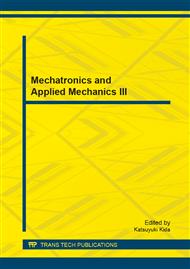[1]
T. HENDRICKS et al, Heavy Vehicle Auxiliary Load Electrification for the Essential Power System Program: Benefits, Tradeoffs, and Remaining Challenges, SAE Technical Paper, International Truck and Bus Meeting and Exhibition, Detroit, Michigan, November 18-20, (2002).
DOI: 10.4271/2002-01-3135
Google Scholar
[2]
T. X. NGHIEM and G. J. PAPPAS, Receding-horizon supervisory control of green buildings, in Proceedings of American Control Conference, San Francisco, CA, 2011, p.4416 – 4421.
DOI: 10.1109/acc.2011.5990995
Google Scholar
[3]
H. ALI BORHAN et al., MPC Based Energy Management of Power-Split Hybrid Electric Vehicle, Control Systems Technology, IEEE Transactions on Volume: 20, Issue: 3, Page 593-603, May (2012).
DOI: 10.1109/tcst.2011.2134852
Google Scholar
[4]
D. AMBUHL and L. GUZZELLA, Predictive Reference Signal Generator for Hybrid Electric Vehicles, in Vehicular Technology, IEEE Transactions on, Volume: 58, Issue: 9, Page: 4730-4740, Nov. (2009).
DOI: 10.1109/tvt.2009.2027709
Google Scholar
[5]
E. HELLSTROM, Look-ahead control for heavy trucks to minimize trip time and fuel consumption, Control Engineering Practice, Volume 17, Issue 2, February 2009, Pages 245–254.
DOI: 10.1016/j.conengprac.2008.07.005
Google Scholar
[6]
KOLMANOVSKY et al., Optimization of powertrain operating policies for feasibility assessment and calibration: Stochastic dynamic programming approach, in American Control Conference, 2002. Proceedings of the 2002 Volume: 2, Page 1425-1430.
DOI: 10.1109/acc.2002.1023221
Google Scholar
[7]
L. JOHANNESSON et al., Assessing the potential of predictive control for hybrid vehicle powertrains using stochastic dynamic programming, in Intelligent Transportation Systems, 2005. Proceedings, 2005 IEEE, Page 366-371.
DOI: 10.1109/itsc.2005.1520076
Google Scholar
[8]
R. FINDEISEN et al, An introduction to Nonlinear Model Predictive Control, Control, 21st Benelux Meeting on Systems and Control, Eindhoven, (2002).
Google Scholar
[9]
F. ALLGOWER et al, Nonlinear Model Predictive Control: From Theory to Application, J. Chin. Inst. Chem. Engrs., Vol. 35, No. 3, 299-315, (2004).
Google Scholar
[10]
O. SUNDSTROM and L. GUZZELLA, A generic dynamic programming MATLAB function, 2009 IEEE Control Applications, (CCA) Intelligent Control, (ISIC), Page 1625-1630.
DOI: 10.1109/cca.2009.5281131
Google Scholar
[11]
C. AUDET and J. E. DENNIS Jr. , Mesh adaptive direct search algorithms for constrained optimization, SIAM Journal on Optimization, 17: 188-217, (2006).
DOI: 10.1137/040603371
Google Scholar


